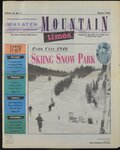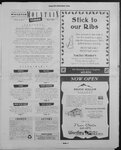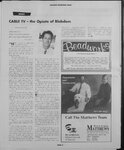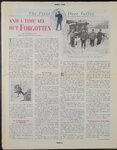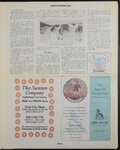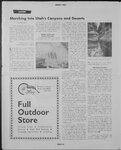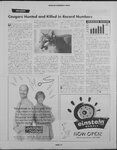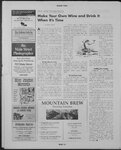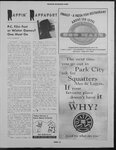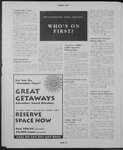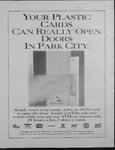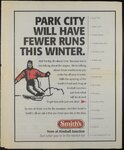| OCR Text |
Show MARCH Tito mM eM Cela CT NL Cy a bird. When |fall let me fall without regret like a leaf. — Wendell Berry A Message from RUTH DRAPKIN 801-649-9200 / 1-800-999-7355 Pe Wardley PRO AUDIO SALES AND SERVICES Sound is the Absence of Bad Sound” 1.800.FOR.KLAY 7054 SOUTH 2300 EAST + SALT LAKE CITY, UTAH 84121 VOICE 801.94. AUDIO + FAX 801.942.3136 : Hite ~ Main Street Helios Park City’s Fastest Finest, Quality Photofinishing 523 Main Street * One-hour Photo * Two-hour Slide Processing (E-6) * KODAK and Inexpensive Make Your Own When It’s Time By Mark Gerard Better Homes & Gardens Klay Anderson Audio Inc “Good Fun Create-A-Print™ * Black & White Processing * Custom Enlarging, Negatives or Slides + Portrait & Commercial Studio * Passport Photos * Unique Photo Frames & Accessories 649-6465 suver Junction Mercantile Every thing You Want But 1996 A“ you interested in a case of good wine for $2 a bottle? That’s just about what it costs to make your own from California wine grape juice. Wine-making at home is simple, requiring only a few pieces of inexpensive equipment The result — if you take a craftsmanlike approach and use high-quality yeast and juice — is comparable to the wines you purchase at the liquor store Wine-making involves just enough applied science to be interesting, but not so much as to be tedious. Basically, you add yeast to fruit juice. Yeast will feed on sugar compounds in the juice and convert them to alcohol and carbon dioxide. In other words, yeast eats sugar, excretes alcohol and passes gas. Grape juice to wine Traditionally, wine is made from fresh wine grape juice called crush. Every fall, Mountain Brew of Salt Lake City trucks in California crush for local home-brewers. They bring in many popular wine varieties, such as Cabernet Sauvignon, Merlot, Colombard and Chablis. Harvest depends on the weather, but generally the crush arrives the beginning of October. If you miss the fresh crush at harvest time, you can buy canned wine grape juice at wine-making stores any time of year. Fermenting and bottling a case — five gallons — of wine requires a few hours during each of four days spread over six months. Besides patience, all that is necessary between steps is a cool, dark place to store your “working” brew. Wine and If you’re using a canned wine grape juice, you’ll need to add sugar in an amount specified on the label to An 11% to 12% alcohol content is important because alcohol _ stabilizes wine, protecting it from organisms from entering the botescape. that will spoil it. For the same reason — bacterial contamination — you should sterilize everything that touches the juice with potassium metabisulfate diluted in warm water. It’s sold in conveniently measured doses called Campden tablets. Fermenting magic The fermenting juice is magic to watch because it begins thick, syrupy and sweet, then slowly transforms into dry-tasting wine with a viscosity similar to water. Fermentation is a prolonged reaction that takes place a room temperature. Most of it happens the first few days after yeast is added to the juice. To contain five gallons of fermenting crush, you need an 8-10 gallon industrial-grade plastic food container or an unused plastic trash can. Stir daily and BREW *A. Friberg *H.F. Sellers eJ.Bama °B. Dolittle (801) 649-8654 558 Main St. ¢ P.O. Box 715 Park City, Utah 84060 SALT LAKE CITY 2793 South State Street ¢ Large Selection of Products at Low Prices 487-2337 OGDEN * Supplies and Advice for the Beginner Through Expert 3417 Riverdale Road 393-2335 ¢ Experienced, Knowledgeable Staff to Help with Any Questions. PAGE brewing tle, but allows bubbles, the carbon dioxide, to “You Can't Sell Original, Limited Editions, Sculpture, New Artists, Framing, Etc. head will develop. the turbulent is finished. Siphon the frothy juice into Brewing Supplier ¢ Complete Brewing Supplies for Beer or Wine Making fermenter, a clean five-gallon carboy — the type that usually holds bottled water. As you siphon, filter the juice through cheesecloth. This is called “racking.” The balance of the fermentation must occur in an airtight container. your Top carboy with an airlock —a cheap, water-filled device that blocks air From An Empty Wagon” — Articipation Galleries a thick foam After six or seven days in this primary ished wine. Don’t worry that you'll get a sweet wine by adding sugar. The yeast will efficiently convert it all to alcohol. Fresh crush is usually sugar-balanced to yield an appropriate alcohol level. MOUNTAIN BINGHAM JUNCTION ANTIQUES and COUNTRY STORE soon achieve 12 percent alcohol in your fin- Can't Find Drink It 1-800-611-5706 jug sit in the dark room termperature Let your airtight for three weeks at or cooler. The air- lock will bubble gently. Rack it again and let it sit for three months. Bottling the vintage Technically, it is now wine. The color will be crisp, translucent and inviting. The aroma is fruity. The taste at this stage though, will be unpromising. Reds may taste like unsweetened prune juice with a medicinal kick, and whites like aviation fuel. Be patient. Indulging in young wine can bequeth a tenacious hangover. It’s agining in the bottle that will develop body and bouquet in your wine. Wine bottles are free if you recycle empties from store-bought wine. Have friends save them for you. You'll be surprised at how quickly two dozen accumulate. Restaurants are also good source of empties. Siphon your wine into clean bottles, filling each to within two and onehalf inches“6f the rim. A simple handoperated wine corker — less than $20 _ — will insert the corks and seal your wine from air. Be sure to buy new corks, don’t use old ones. Store your corked bottles on their sides in a dark place. Three months of aging is good, six months to a year is better. The magic that converts raw fruit to agreeable wine can’t be rushed. Mountain Brew will be happy to provide you with complete wine-making recipes and help you get started. The following books will provide background information: From Vines to Wines, by Jeff Cox, Harper and Row; Wine-making at Home, by Bruce Plamer, Workman Publishing; Winemaking at Home by Homer Hardwick, Funk & Wagnalls; and Amateur Winemaking and Brewing, by Duncan Gillespie, Hodder and Stoughton. @ |

